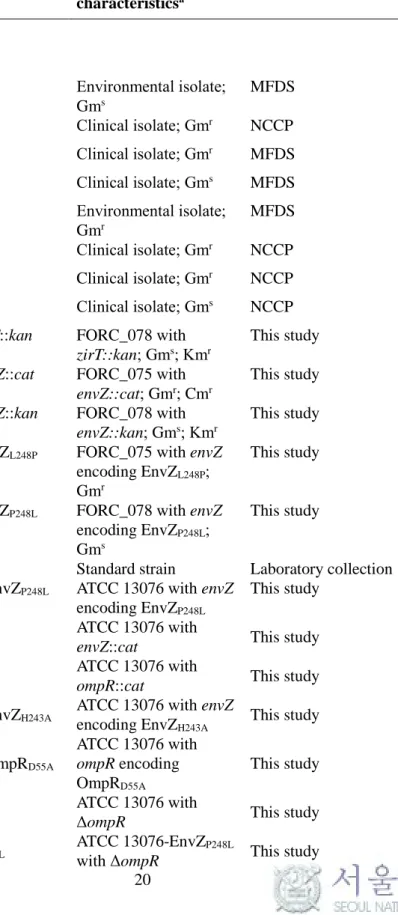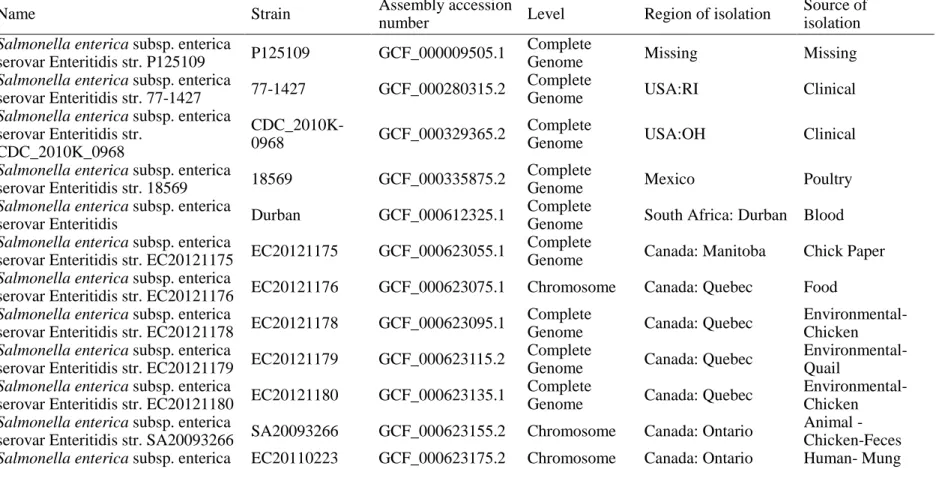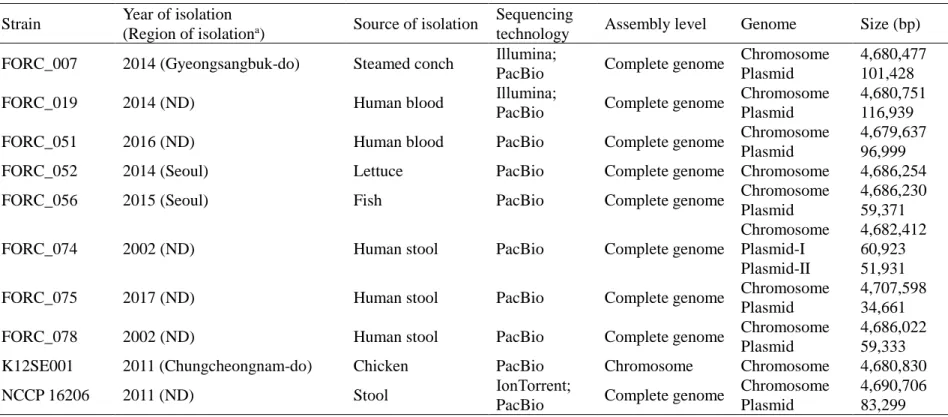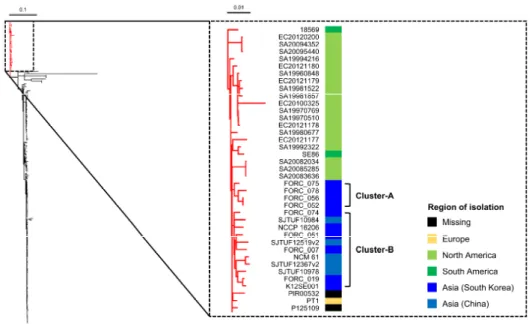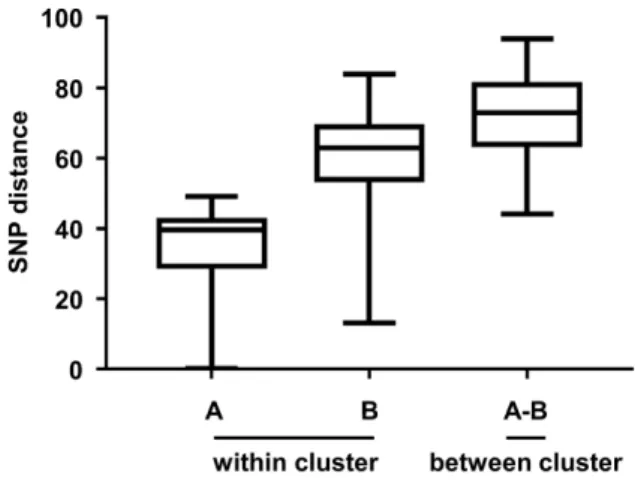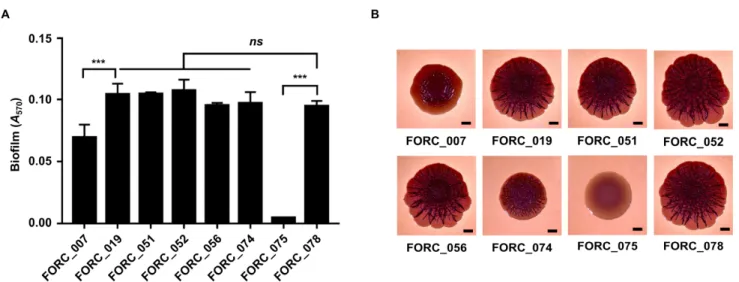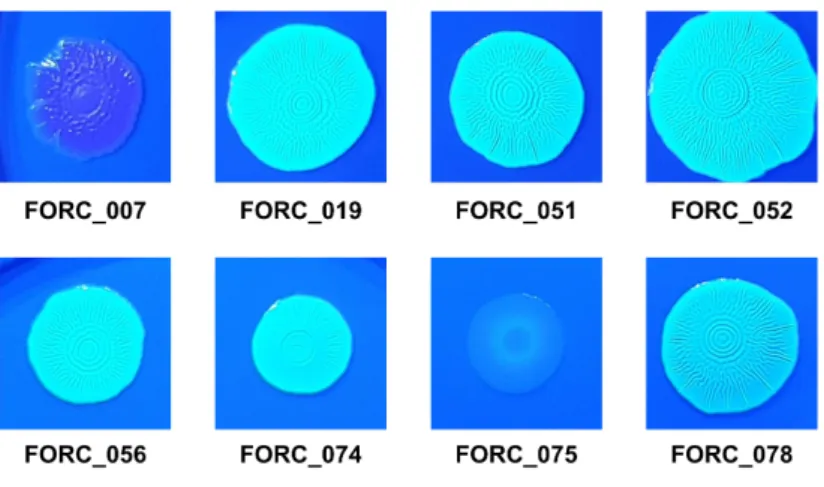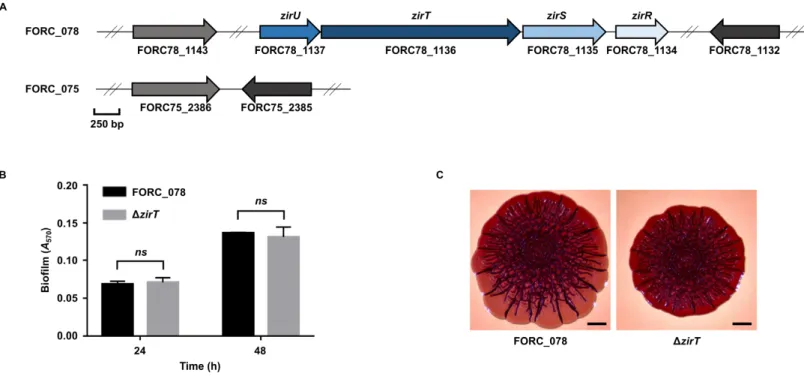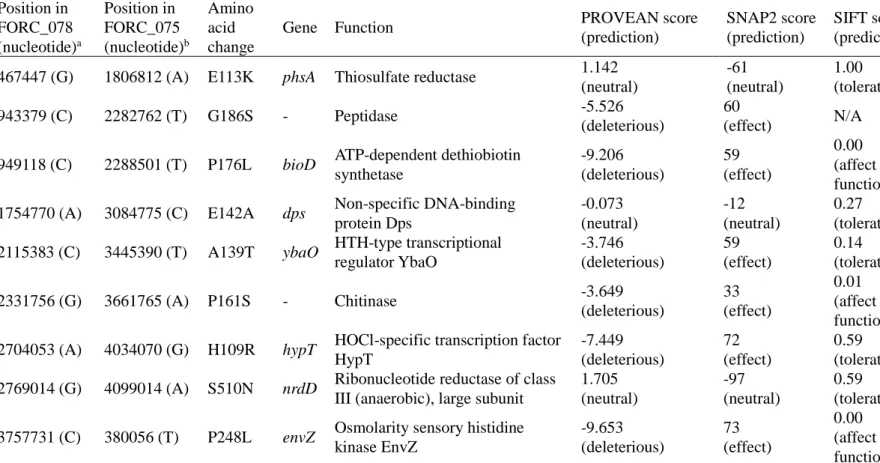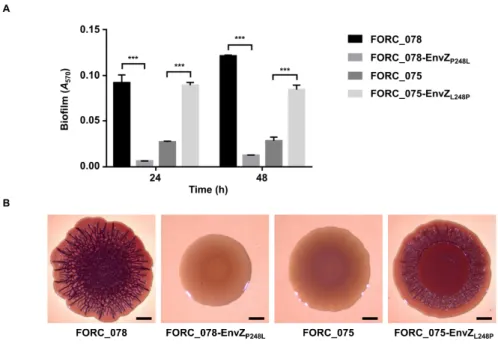저작자표시-비영리-변경금지 2.0 대한민국 이용자는 아래의 조건을 따르는 경우에 한하여 자유롭게
l 이 저작물을 복제, 배포, 전송, 전시, 공연 및 방송할 수 있습니다. 다음과 같은 조건을 따라야 합니다:
l 귀하는, 이 저작물의 재이용이나 배포의 경우, 이 저작물에 적용된 이용허락조건 을 명확하게 나타내어야 합니다.
l 저작권자로부터 별도의 허가를 받으면 이러한 조건들은 적용되지 않습니다.
저작권법에 따른 이용자의 권리는 위의 내용에 의하여 영향을 받지 않습니다. 이것은 이용허락규약(Legal Code)을 이해하기 쉽게 요약한 것입니다.
Disclaimer
저작자표시. 귀하는 원저작자를 표시하여야 합니다.
비영리. 귀하는 이 저작물을 영리 목적으로 이용할 수 없습니다.
변경금지. 귀하는 이 저작물을 개작, 변형 또는 가공할 수 없습니다.
A Thesis for the Degree of Doctor of Philosophy
Genomic and Functional Analyses of
EnvZ/OmpR Two-Component System Modulating Virulence and Antibiotic Resistance of
Salmonella enterica Serovar Enteritidis
살모넬라 엔테리티디스균의 병원성 및 항생제 내성을 조절하는 EnvZ/OmpR two-component system 의
유전적 특성 및 기능 연구
August, 2022
Duhyun Ko
Department of Agricultural Biotechnology The Graduate School
Seoul National University
Genomic and Functional Analyses of
EnvZ/OmpR Two-Component System Modulating Virulence and Antibiotic Resistance of
Salmonella enterica Serovar Enteritidis
살모넬라 엔테리티디스균의 병원성 및 항생제 내성을 조절하는 EnvZ/OmpR two-component system 의
유전적 특성 및 기능 연구
지도교수 최 상 호
이 논문을 농학박사학위논문으로 제출함 2022 년 5 월
서울대학교 대학원 농생명공학부
고 두 현
고두현의 박사학위논문을 인준함 2022 년 6 월
위 원 장 ___________________(인) 부위원장 ___________________(인) 위 원 ___________________(인) 위 원 ___________________(인)
Abstract
Genomic and Functional Analyses of
EnvZ/OmpR Two-Component System Modulating Virulence and Antibiotic Resistance of Salmonella enterica Serovar Enteritidis
Duhyun Ko Department of Agricultural Biotechnology The Graduate School Seoul National University
Pathogenic bacteria encounter various environmental conditions during their infection cycle. Under certain environments, genetic mutations occur naturally and often enhance bacterial survival and virulence. In the present study, the function of specific genetic mutation in the envZ gene, which encodes a sensor kinase of EnvZ/OmpR two-component system, has been identified in a food-borne pathogen Salmonella enterica serovar Enteritidis. A phylogenetic analysis of the S. Enteritidis strains showed that 8 strains of S. Enteritidis isolated in South Korea, including FORC_075 and FORC_078, have almost identical genome sequences. Interestingly,
colonies were significantly impaired, resulting in phenotypic differences among the 8 strains. Comparative genomic analyses revealed that one of the non-synonymous single nucleotide polymorphisms (SNPs) unique to FORC_075 has occurred in envZ.
The SNP in envZ leads to an amino acid change from Pro248 (CCG) in other strains including FORC_078 to Leu248 (CTG) in FORC_075. Allelic exchange of envZ between FORC_075 and FORC_078 identified that the SNP in envZ is responsible for the impaired biofilm- and RDAR colony-forming abilities of S. Enteritidis.
Biochemical analyses demonstrated that the SNP in envZ significantly increases the phosphorylated status of OmpR in S. Enteritidis and alters the expression of the OmpR regulon. Phenotypic analyses further identified that the SNP in envZ decreases motility of S. Enteritidis but increases its adhesion and invasion to both human epithelial cells and murine macrophage cells. In addition, survival under acid stress is also elevated by the SNP in envZ. Altogether, these results suggest that the natural occurrence of the SNP in envZ could contribute to phenotypic diversity of S.
Enteritidis, possibly improving its fitness and pathogenesis. Meanwhile, little is known about the role of EnvZ/OmpR in antibiotic resistance, except that it regulates the expression of OmpC and OmpF, two outer membrane porins (OMPs) permeable to small hydrophilic antibiotics. To determine the role of EnvZ/OmpR in antibiotic resistance, two mutant strains of S. Enteritidis expressing different phosphorylated status of OmpR were first generated. The mutant strains showing high and low
states of EnvZ/OmpR, respectively. Interestingly, it was found that resistance to various antibiotics, especially β-lactams, in S. Enteritidis is elevated by the active state of EnvZ/OmpR. Transcriptome analysis newly discovered that the active state of EnvZ/OmpR induces a differential expression of multiple OMP genes besides ompC and ompF, including SEN1522, SEN2875, ompD, and ompW. Biochemical analyses demonstrated that OmpR alters the OMP composition in S. Enteritidis by directly activating SEN1522 and SEN2875 but repressing ompD and ompW. Non- canonically, a high cellular level of OmpR caused by the active state of EnvZ/OmpR is required for the regulation of the four OMP genes. In particular, phosphorylation of OmpR is not necessary for the repression of ompD and ompW. Phenotypic analysis revealed that among the four OMP genes, the decreased expression of ompD, in addition to ompF, is responsible for the EnvZ/OmpR-mediated resistance to β- lactams in S. Enteritidis. Notably, EnvZ/OmpR specifically responds to β-lactams and provides S. Enteritidis with benefits for survival upon exposure to the antibiotics.
Taken to together, these results suggest that EnvZ/OmpR remodels the OMP composition in response to β-lactams and thereby contributes to the enhanced resistance in S. Enteritidis to the antibiotics. In conclusion, this study demonstrated the phenotypic diversity of S. Enteritidis attributed to specific genetic mutation in envZ and the mechanism by which the active state of EnvZ/OmpR improves antibiotic resistance in S. Enteritidis.
Keywords: Salmonella enterica serovar Enteritidis, EnvZ/OmpR two- component system, SNP, Phenotypic diversity, Virulence, Antibiotic resistance Student number: 2019-36715
Contents
Abstract ...I Contents ... V List of Figures ... IX List of Tables ... XI
Chapter I. Background ... 1
I-1. Salmonella enterica serovar Enteritidis ... 2
I-1-1. Virulence factors of S. Enteritidis ... 4
I-1-2. Antibiotic resistance of S. Enteritidis ... 6
I-1-3. Two-component systems of S. Enteritidis ... 9
I-2. Objective of this study ... 13
Chapter II. An SNP in envZ potentially leading to phenotypic diversity of Salmonella enterica serovar Enteritidis ... 14
II-1. Introduction ... 15
II-2. Materials and Methods ... 19
II-2-1. Strains, plasmids, and culture conditions ... 19
II-2-2. Comparative genomic analysis ... 23
II-2-3. Biofilm formation ... 43
II-2-4. Colony morphology assay ... 43
II-2-6. Generation of single nucleotide substitution mutants ... 49
II-2-7. Purification of OmpR and Western blot analysis ... 50
II-2-8. RNA purification and transcript analysis ... 51
II-2-9. Motility, adhesion, invasion, and acid resistance assay ... 51
II-2-10. Sequence analysis ... 52
II-2-11. Data analysis ... 53
II-3. Results ... 54
II-3-1. The S. Enteritidis strains isolated in South Korea have a close genetic relationship ... 54
II-3-2. FORC_075 exhibits an impaired biofilm formation and a SAW colony morphology ... 59
II-3-3. A single SNP in envZ is responsible for the distinct phenotypes of FORC_075 ... 63
II-3-4. SNP in envZ increases OmpR-P level and alters OmpR regulon expression ... 71
II-3-5. SNP in envZ determines the virulence-related phenotypes of S. Enteritidis ... 75
II-3-6. The effects of the SNP in envZ are not dependent on a particular S. Enteritidis genetic background ... 79 II-3-7. The SNP in envZ can naturally occur in other Salmonella strains82
Chapter III. Mechanism of antibiotic resistance mediated by EnvZ/OmpR two-
component system in Salmonella enterica serovar Enteritidis ... 90
III-1. Introduction ... 91
III-2. Materials and Methods ... 94
III-2-1. Strains, plasmids, and culture conditions ... 94
III-2-2. Mutant construction ... 94
III-2-3. Western blot analysis ... 95
III-2-4. Antimicrobial susceptibility test ... 96
III-2-5. Transcriptome analysis and quantitative reverse transcription-PCR (qRT-PCR) ... 96
III-2-6. Outer membrane protein purification and identification ... 97
III-2-7. Purification of OmpR, electrophoretic mobility shift assay (EMSA), and DNase I protection assay. ... 98
III-2-8. Manipulation of the cellular level of OmpR ... 100
III-2-9. Construction of ompR-lacZ transcriptional fusion reporter and β- galactosidase activity assay. ... 100
III-2-10. Data analysis ... 101
III-2-11. Accession number ... 101
III-3. Results ... 102 III-3-1. The antibiotic resistance in S. Enteritidis is enhanced by the active
III-3-2. The active state of EnvZ/OmpR induces differential expression of
antibiotic resistance-related OMP genes ... 106
III-3-3. OmpR directly regulates the SEN1522, SEN2875, ompD, and ompW genes and alters the OMP composition ... 132
III-3-4. High cellular level of OmpR is required for the regulation of the four OMP genes ... 138
III-3-5. Phosphorylation of OmpR is not necessary for the repression of the ompD and ompW genes ... 140
III-3-6. The ompD and ompF genes play a major role in the EnvZ/OmpR- mediated antibiotic resistance ... 143
III-3-7. EnvZ/OmpR specifically responds to β-lactams and enhances antibiotic resistance ... 144
III-4. Discussion ... 150
Chapter IV. Conclusion ... 155
References ... 159
국문초록 ... 176
List of Figures
Figure II-1. Phylogenetic tree of the S. Enteritidis strains...57
Figure II-2. Pairwise SNP distances between the S. Enteritidis strains...58
Figure II-3. Distinct biofilm formation and colony morphology of FORC_075...61
Figure II-4. Colony morphologies of the S. Enteritidis strains on CFW agar plates..62
Figure II-5. Effects of the zirT mutation on biofilm formation and colony morphology...66
Figure II-6. SNP in envZ responsible for the distinct biofilm phenotypes...70
Figure II-7. Effects of the SNP in envZ on the OmpR-P level and OmpR regulon expression...73
Figure II-8. Effect of SNP in envZ on motility...74
Figure II-9. Effect of SNP in envZ on infectivity to host cells...77
Figure II-10. Effect of SNP in envZ on survival under acid stress...78
Figure II-11. Effects of the SNP in envZ on various phenotypes of ATCC 13076...80
Figure II-12. Proposed model for the effects of the SNP in envZ...89
Figure III-1. The phosphorylation level of OmpR in S. Enteritidis with different genetic backgrounds...104
Figure III-2. Transcriptome analyses for DEGs by the envZP248L and envZH243A mutations...127
Figure III-4. Direct binding of OmpR to the upstream regions of the EnvZ/OmpR regulon...135 Figure III-5. Specific binding of OmpR to the upstream regions of the EnvZ/OmpR regulon...136 Figure III-6. The OMP composition of S. Enteritidis with different genetic
backgrounds...137 Figure III-7. Effects of the cellular level of OmpR on the expression of the
EnvZ/OmpR regulon...139 Figure III-8. Effects of unphosphorylated OmpR on the expression of the
EnvZ/OmpR regulon...141 Figure III-9. Effects of ceftriaxone on the activity of PompR and expression of the EnvZ/OmpR regulon...146 Figure III-10. Effects of various antibiotics on the activity of PompR...148 Figure III-11. Survival of S. Enteritidis upon exposure to β-lactams...149 Figure III-12. Proposed mechanism of antibiotic resistance enhanced by
EnvZ/OmpR in S. Enteritidis...153 Figure IV-1. Phenotypic changes induced by the active state of EnvZ/OmpR in S. Enteritidis...158
List of Tables
Table II-1. Bacterial strains and plasmids used in this study...20
Table II-2. List of the S. Enteritidis strains in Figure II-1...25
Table II-3. Oligonucleotides used in this study...45
Table II-4. General information of the S. Enteritidis strains isolated in South Korea...56
Table II-5. Non-synonymous SNPs unique to the FORC_075 strain...68
Table II-6. Salmonella strains carrying the SNP allele of FORC_075 envZ...83
Table III-1. Antibiotic resistance in S. Enteritidis with different genetic backgrounds...105
Table III-2. Effects of the OMP genes on antibiotic resistance in S. Enteritidis...108
Table III-3. List of DEGs by the envZP248L and envZH243A mutations...109
Table III-4. List of DEGs belonging to the enriched GO terms in Figure III-1B...129
Chapter I.
Background
I-1. Salmonella enterica serovar Enteritidis
Salmonella enterica is a Gram-negative, rod-shaped, and motile bacterium with peritrichous flagella, which belongs to Enterobacteriaceae. S. enterica is divided into six subspecies identified by DNA-DNA hybridization: subsp. enterica (I), subsp.
salamae (II), subsp. arizonae (IIIa), subsp. diarizonae (IIIb), subsp. houtenae (IV), and subsp. indica (VI) (Achtman et al., 2012). S. enterica subsp. enterica (I) is highly associated with infections in human and warm-blooded animals, while the other five subspecies of S. enterica are usually isolated from cold-blooded animals and environments (Baumler et al., 1998; Brenner et al., 2000). S. enterica is also classified into more than 2,600 different serovars by a Kauffman-White method which identifies serologic variations of somatic (O) and flagellar (H) antigens, and the majority of the S. enterica serovars belongs to S. enterica subsp. enterica (I) (Brenner et al., 2000; Kauffmann, 1966).
S. enterica is a major food-borne pathogen worldwide. The S. enterica serovars differ in their host range and the ability to cause diseases, called salmonellosis. Based on the symptoms of salmonellosis, the S. enterica serovars are divided into typhoidal Salmonella and non-typhoidal Salmonella (NTS). Typhoidal Salmonella including S.
enterica serovar Typhi and S. enterica serovar Paratyphi A is a human-restricted pathogen that causes enteric fever, an invasive disease leading to about 136,000
most of the S. enterica serovars has a broad host range and usually causes mild gastroenteritis. However, some NTS strains are also responsible for the invasive diseases inducing bacteremia and systemic infections (Gal-Mor et al., 2014). It has been reported that the NTS strains cause 93.8 million illnesses with 155,000 deaths each year worldwide (Majowicz et al., 2010).
Among the NTS, S. enterica serovar Enteritidis is one of the frequently isolated serovars in many countries, accounting for most cases of human salmonellosis (Braden, 2006). Infection by S. Enteritidis usually occurs through the ingestion of contaminated food products. Because S. Enteritidis has a superior ability to survive in egg white compared with other S. enterica serovars, eggs are the most important source for its transmission to humans (De Vylder et al., 2013; Sher et al., 2021). Upon ingested, S. Enteritidis encounters extremely acidic condition at the stomach. The survived pathogen adheres to the intestinal epithelial cells and invades them by promoting bacterial-mediated endocytosis (Ohl & Miller, 2001). When the epithelial barrier is disrupted, S. Enteritidis is engulfed by phagocytic cells such as macrophages and dendritic cells. Within the phagocytic cells, S. Enteritidis forms Salmonella-containing vacuoles (SCVs), a niche to evade the immune responses and successfully replicate (Steele-Mortimer, 2008). As the infected phagocytic cells migrate to other organs, the pathogen is disseminated, resulting in systemic infection (Ohl & Miller, 2001). These pathological features of S. Enteritidis infection are
interact with host cells.
I-1-1. Virulence factors of S. Enteritidis
Fimbriae
Fimbriae are filamentous polymeric proteins located at the bacterial surface (Mol &
Oudega, 1996). In general, S. Enteritidis carries 13 fimbrial gene clusters (csg, bcf, lpf, peg, saf, sef, stb, std, ste, stf, sth, sti, and fim) which consist of more than 4 genes encoding fimbrial subunits, chaperones, and regulatory proteins. S. Enteritidis uses fimbriae to interact with specific receptor of host cells, which results in adhesion and colonization (Rehman et al., 2019). For example, FimH binds to glycoprotein 2 of M cell, a modified intestinal cell found in mucosa-associated lymphoid tissue, leading to efficient invasion of S. enterica (Ohno & Hase, 2010). In addition, the fimbrial structure are important for bacterial aggregation and biofilm formation (Rehman et al., 2019).
Type III secretion systems (T3SSs)
T3SS is a needle-like apparatus that translocates effector proteins into the cytosol of host cells. S. Enteritidis has two T3SSs, T3SS-1 and T3SS-2, which are encoded by Salmonella pathogenicity island-1 (SPI-1) and SPI-2, respectively. T3SS-1 and
upon contact with host cell and essential for S. Enteritidis to invade intestinal epithelial cells and to induce inflammation (Gerlach & Hensel, 2007). The effector proteins translocated through T3SS-1 such as SopE, SopB, and SipA interact with Rho-family GTPases, leading to actin cytoskeletal disruption and bacterial internalization (Boyle et al., 2006; Gerlach & Hensel, 2007). SopB also activates chloride secretion of the epithelial cells, inducing diarrhea (Norris et al., 1998).
Furthermore, SipA promotes not only actin polymerization but also transepithelial migration of leukocytes, leading to intestinal inflammation (Wall et al., 2007).
T3SS-2 is activated inside the phagocytic cells and translocates effector proteins to form and maintain SCVs (Gerlach & Hensel, 2007). SpiC is the first reported effector protein translocated by T3SS-2 to inhibit formation of phagolysosome (Uchiya et al., 1999). The SseF and SseG proteins interact with each other and contribute to Salmonella-induced filaments (Sifs) formation as well as intracellular replication (Deiwick et al., 2006). Accordingly, T3SS-2 of S. Enteritidis plays a critical role in the development of systemic infection.
Magnesium uptake systems
Magnesium (Mg2+), the second-most abundant cation in living cells, is an essential micronutrient as a cofactor for many enzymatic reactions (Flatman, 1991). After phagocytosis, macrophages lower the Mg2+ concentration of the phagosome to
nutritional deprivation inside the phagosome, S. Enteritidis has several magnesium transporters: CorA, MgtA, and MgtB. CorA is the primary Mg2+ channel expressed constitutively, and its energy source for Mg2+ transport is a membrane potential (Groisman et al., 2013). The corA mutant of S. enterica shows decreased invasion and intracellular replication and attenuated virulence in mouse model (Papp-Wallace et al., 2008). MgtA and MgtB are P-type ATPases which obtain energy from ATP hydrolysis for Mg2+ uptake (Groisman et al., 2013). The expression of mgtA and mgtB is inducible in response to low Mg2+ concentration (Snavely et al., 1991).
MgtB is a specific Mg2+ uptake system of S. enterica, encoded by the mgtCB operon located in SPI-3.
I-1-2. Antibiotic resistance of S. Enteritidis
The discovery of antimicrobial agents to treat infections by pathogenic microorganisms is one of the greatest advances of the 20th century (Katz & Baltz, 2016). Especially, antibiotics enable the development of modern medical approahces including organ transplantation and cancer management (Munita & Arias, 2016).
Because antibiotics inhibit bacterial growth, antibiotic resistance is a natural and inevitable consequene. However, misuses and abuses of antibiotics have accelerated the emergence of bacteria resistant to multiple antibiotics (French, 2010). As a result, antibiotic reisistance has now been considered as one of the biggest threats to public
Bacteria exhibit three types of antibiotic resistance: intrinsic, acquired, and adaptive resistance (Fernandez & Hancock, 2012). Intrinsic resistance is a natural property of bacterial species to resist particular antibiotics (Fernandez & Hancock, 2012). For example, Vibrio cholerae carries unique lipid A modification system in its chromosome responsible for polymyxin B resistance (Herrera et al., 2014). In addition, the efflux pump systems conserved in Pseudomonas aeruginosa contribute to resistant to multiple antibiotics including tetracycline and erythromycin (Masuda et al., 2000). Acquired resistance is provided by acquisition of genetic materials or spontaneous mutations, which allows antibiotic susceptible bacteria to be resistant (Fernandez & Hancock, 2012). Finally, adaptive resistance is a temporary property that decreases the antibiotic susceptibility of bacteria by altering the expression of genes upon exposure to specific environments (Fernandez & Hancock, 2012).
Through these three types of antibiotic resistance, S. Enteritidis has developed diverse mechanisms to survive in the antibiotic treatments. This section will describe three major mechanisms by which S. Enteritidis shows antibiotic resistance.
Enzymatic inactivation of antibiotics
One of the mechanisms of antibiotic resistance is a production of enzymes that inactivate antibiotics. As many antibiotics have chemical bonds susceptible to hydrolytic cleavage, several enzymes have evolved to hydrolyze the bonds and
hydrolyzing β-lactam ring of antibiotics belonging to penicillins and cephalosporins (Poole, 2004). Some enzymes transfer chemical moieties to the antibiotics rather than degrade them, inducing steric hindrance and decreasing the access of antibiotics to their intracellular targets (Munita & Arias, 2016). For example, aminoglycoside acetyltransferases transfer an acetyl group to the aminoglycosides that bind to ribosomal proteins and inhibit protein biosynthesis. Due to this structural modification, the binding affinity of aminoglycosides to the ribosomal proteins is reduced, and thus the antibiotic activity is also reduced (Disney, 2012).
Alteration of target sites for antibiotics
To inhibit bacterial growth, antibiotics target essential cellular processes including DNA replication and cell wall and protein biosynthesis. Fluoroquinolones interfere DNA replication by inhibiting the activity of DNA gyrase encoded by gyrA and gyrB and topoisomerase IV encoded by parC and parE (Blondeau, 2004). Chromosomal mutations in these genes possibly decrease affinity of gyrase or topoisomerase IV to fluoroquinolones, leading to antibiotic resistance (Kumar et al., 2015). In addition, mutations in 16S rRNA confer resistance to several antibiotics belonging to aminoglycosides (Recht & Puglisi, 2001).
Limitation of influx in antibiotics
influx of toxic compounds including antibiotics. Indeed, vancomycin is inactive against Gram-negative bacteria because the antibiotic can not penetrate their outer membrane (Fernandes et al., 2017). Hydrophilic antibiotics such as β-lactams, tetracyclines, and some fluoroquinolones enter into the cells through the water-filled outer membrane porins (OMPs). Thus, reduction in the number of porins or modification of porin selectivity leads to a decrease in outer membrane permeability and thus reduces the influx in antibiotics. OmpC and OmpF are the most abundant OMPs in S. enterica. Accordingly, mutations in ompC and ompF increase bacterial resistance to β-lactams or fluoroquinolones (Futoma-Koloch et al., 2019; Medeiros et al., 1987). In addition to OMPs, overexpression of efflux pump systems, which consist of outer membrane protein TolC and inner membrane and periplasmic proteins such as AcrAB, confers mutidrug resistance to many bacteria (Blair et al., 2015).
I-1-3. Two-component systems of S. Enteritidis
Two-component system (TCS) is a signal transduction system of bacteria to sense and respond to various environments. TCS consists of a sensor kinase and its cognate response regulator. Generally, the sensor kinase contains the dimerization and histidine phosphotransfer (DHp) domain and catalytic and ATP binding (CA) domain, and the response regulator contains an N-terminal receiver domain and a C-terminal
condition, a histidine residue conserved in the DHp domain of sensor kinase is autophosphorylated, and a phosphoryl group is transferred to an aspartate residue conserved in the receiver domain of response regulator (Capra & Laub, 2012). When the response regulator is phosphorylated, its conformation is changed, facilitating DNA-binding and gene regulation. Mostly, the sensor kinase has both kinase and phosphatase activities to modulate the phosphorylated status of its cognate response regulator (Gao & Stock, 2009). TCSs play important roles in cellular processes such as nutrient uptake, chemotaxis, pathogenesis, and antibiotic resistance. This section will describe several TCSs and their physiological roles in S. Enteritidis.
SsrA/SsrB
SsrA/SsrB TCS consists of sensor kinase SsrA and response regulator SsrB. The ssrA and ssrB genes are located in the SPI-2 region, and thus, uniquely found in S. enterica.
Although environmental signals directly sensed by SsrA are still unknown, it is speculated that SCV-like condition is possibly associated with the activation of SsrA/SsrB TCS (Lee et al., 2000). SsrB is a NarL/FixJ-type of response regulator.
The C-terminal domain of SsrB comprises four α-helices containing helix-turn-helix DNA binding domain (Carroll et al., 2009). SsrB regulates the expression of the SPI- 2 genes as well as other non-SPI-2 genes but acquired by horizontal gene transfer (Worley et al., 2000). Furthermore, recent studies suggested that SsrB represses the
SPI-1 genes, playing a key transcriptional regulator that helps transition of S.
enterica from extracellular to intracellular lifestyle (Perez-Morales et al., 2017).
EnvZ/OmpR
EnvZ/OmpR TCS consists of sensor kinase EnvZ and response regulator OmpR. The envZ and ompR genes are widely conserved in many bacteria including Escherichia coli, S. enterica, and Yersinia species. EnvZ/OmpR has been reported to regulate the expression of two OMPs OmpC and OmpF in response to the external osmolarity (Slauch et al., 1988). High osmolarity induces conformational change of EnvZ to be more stable, leading to increased autophosphorylation of EnvZ and phosphotransfer to OmpR (Wang et al., 2012). In S. enterica, the EnvZ activity is also responsive to changes in pH (Mideros-Mora et al., 2020). OmpR has a winged helix-turn-helix motif in its DNA-binding domain and interacts more with the phosphate backbone of DNA than with specific bases. Thus, OmpR recognizes DNA regions less specifically than other response regulators (Quinn et al., 2014). This property would allow OmpR to act as a global regulator that controls various phenotypes of S.
Enteritidis. For example, OmpR directly activates the ssrA and ssrB genes which are critical for the pathogenesis of S. enterica (Lee et al., 2000). OmpR also controls biofilm formation of S. enterica by regulating the expression of csgD which encodes
a master regulator of curli and cellulose biosynthesis (Gerstel et al., 2006; Gerstel et al., 2003).
PhoQ/PhoP
PhoQ/PhoP TCS consists of sensor kinase PhoQ and response regulator PhoP. It has been demonstrated that PhoQ is activated by a variety of environmental signals similar to intracellular conditions, such as low Mg2+ concentration, mildly acidic pH, and the presence of cationic antimicrobial peptides (CAMPs) (Groisman et al., 2021).
PhoP is a OmpR/PhoB-type of response regulator with a winged helix-turn-helix motif for DNA binding. PhoP activates the expression of Mg2+ transporters MgtA and MgtB, and thus mutant of phoP shows impaired growth in extremely low Mg2+
concentration (Vescovi et al., 1996). PhoP also activates the pagP gene related to lipopolysaccharide modification and confers resistance to CAMPs (Groisman, 2001).
Recently, it has been reported that PhoQ senses high osmolarity independently of EnvZ and induces phosphorylation of PhoP, accelerating the resumption of bacterial growth under the osmotic stress (Yuan et al., 2017).
I-2. Objective of this study
Acquisition of accessory genes as well as spontaneous chromosomal mutation such as single nucleotide polymorphism (SNP) have a great potential to lead to the evolution of pathogenic bacteria. With the development of next-generation sequencing technology, a number of whole genome sequences of bacteria have been accumulated, which enables comprehensive identification of genetic variations within the bacterial species. A major food-borne pathogen S. Enteritidis usually induces mild gastroenteritis but often causes systemic infection which should be treated with antibiotics. Genomic analysis of S. Enteritidis would provide insights into the genetic basis for its ability to survive and develop food-borne diseases. In the present study, I compared whole genome sequences of the S. Enteritidis strains and found a unique non-synonymous SNP in the envZ gene encoding the sensor kinase of EnvZ/OmpR two-component system. I demonstrated that the SNP in envZ is a key genetic determinant for virulence-related phenotypes of S. Enteritidis including biofilm formation, motility, infectivity to host cells, and acid resistance.
Furthermore, it was found that the envZ gene carrying the SNP enhances the antibiotic resistance of S. Enteritidis, and its molecular mechanism was identified.
Chapter II.
An SNP in envZ potentially leading to phenotypic
diversity of Salmonella enterica serovar Enteritidis
II-1. Introduction
Bacterial pathogens have evolved genetically to adapt to various environmental conditions (Arber, 2000). Many studies have revealed that genetic mutations occur naturally in bacteria for their optimal fitness and successful pathogenesis during the course of infection (Lieberman et al., 2011; Yang et al., 2011).
Horizontal gene transfer, one of the possible mechanisms for genetic evolution, results in the acquisition of novel genes and enables non-pathogenic bacteria to be pathogenic (Kelly et al., 2009). Alternatively, small genetic changes such as single nucleotide polymorphisms (SNPs) have potential to modify the function of original genes and to induce phenotypic diversity of pathogens, leading to their pathoadaptive evolution (Sokurenko et al., 1999). Along with the rapid development of next-generation sequencing technologies, comparative genomic analysis has discovered a number of SNPs occurring in many pathogenic bacteria including Clostridium difficile, Mycobacterium tuberculosis, and Salmonella enterica (Collery et al., 2017; Mikheecheva et al., 2017; Scaltriti et al., 2015). However, studies on the association of each SNP with bacterial pathogenesis are still limited.
S. enterica serovar Enteritidis is a major food-borne pathogen, which causes diseases ranging from mild gastroenteritis to severe systemic infection
component systems to recognize diverse environmental changes and to respond appropriately (Capra & Laub, 2012). The EnvZ/OmpR two-component system is well-studied in Salmonella. The sensor kinase EnvZ phosphorylates itself and transfers the phosphoryl group to its cognate response regulator OmpR in response to specific environmental signals such as osmolarity and pH change (Chakraborty et al., 2017; Delgado et al., 1993; Wang et al., 2012).
Phosphorylation induces conformational changes of OmpR, which enhances its DNA binding affinity (Head et al., 1998), and thus, the expression of the OmpR regulon is mostly dependent on the amount of phosphorylated OmpR (OmpR- P). The OmpR regulon includes ompF and ompC, which encode outer membrane porins, and regulation of their expression is well characterized. A low level of OmpR-P is enough to activate the transcription of ompF, but not of ompC (Aiba & Mizuno, 1990). In contrast, a high level of OmpR-P activates ompC transcription, while repressing ompF transcription (Aiba & Mizuno, 1990).
The EnvZ/OmpR two-component system also regulates virulence-related genes and plays an essential role in the pathogenesis of Salmonella (Dorman et al., 1989; Quinn et al., 2014). For example, the EnvZ/OmpR system controls the expression of csgD, which encodes a master regulator activating the biosynthesis of curli fimbriae and cellulose (Gerstel et al., 2003; Hammar et al.,
components and contribute to the development of a red, dry, and rough (RDAR) colony morphology (Austin et al., 1998; Romling, 2005; Solano et al., 2002).
In addition, the EnvZ/OmpR system represses expression of flagellar genes such as fljB and fliC, which are associated with the motility of Salmonella (Xu et al., 2010). The EnvZ/OmpR system positively regulates the expression of hilA, encoding a major activator of virulence genes located in the Salmonella pathogenicity island 1 (SPI-1), and the expression of ssrA and ssrB, encoding a master activator of the SPI-2 genes (Ellermeier et al., 2005; Feng et al., 2003;
Lee et al., 2000). The SPI-1 and SPI-2 encode type III secretion systems and enable the efficient invasion to host cells and intracellular replication (Galan, 1996; Groisman & Ochman, 1993, 1997; Shea et al., 1996). Furthermore, OmpR itself is an acid shock protein and regulates the expression of genes that are necessary for acid resistance (Bang et al., 2000; Chakraborty & Kenney, 2018; Chakraborty et al., 2015; Chakraborty et al., 2017).
In the present study, we conducted a phylogenetic analysis of 241 strains of S.
Enteritidis and revealed that 8 strains isolated in South Korea, including FORC_075 and FORC_078, have almost identical genome sequences.
Interestingly, however, distinct phenotypes were observed in FORC_075 which showed an impaired biofilm formation and a smooth and white (SAW) colony morphology. We identified that 9 non-synonymous SNPs have occurred
acid change from Pro248 in other strains including FORC_078 to Leu248 in FORC_075. By exchanging the SNP allele in envZ between FORC_075 and FORC_078, we demonstrated that the SNP in envZ determines the biofilm formation and colony morphology. The SNP in envZ induces functional modification of EnvZ, increasing the cellular level of OmpR-P in S. Enteritidis and altering the expression of the OmpR regulon. Further phenotypic analyses revealed that the SNP in envZ decreases motility, but increases both adhesion and invasion to host cells and elevates survival under acid stress. Taken together, these results suggest that the natural occurrence of the SNP in envZ plays a critical role in differentiating the virulence-related phenotypes of S. Enteritidis and thus, contributes to its phenotypic diversity.
II-2. Materials and Methods
II-2-1. Strains, plasmids, and culture conditions
The strains and plasmids used in this study are listed in Table II-1. Unless otherwise noted, all strains were grown aerobically in Luria-Bertani (LB) medium at 37°C. When required, antibiotics were added to the medium at the following concentrations: ampicillin, 100 μg/ml; kanamycin, 100 μg/ml;
chloramphenicol, 20 μg/ml. Bacterial growth was monitored spectrophotometrically at 600 nm (A600).
Table II-1. Bacterial strains and plasmids used in this study Strain or plasmid Relevant
characteristicsa Reference or sourceb, c Bacterial strains
S. Enteritidis
FORC_007 Environmental isolate;
Gms
MFDS
FORC_019 Clinical isolate; Gmr NCCP
FORC_051 Clinical isolate; Gmr MFDS
FORC_052 Clinical isolate; Gms MFDS
FORC_056 Environmental isolate;
Gmr
MFDS
FORC_074 Clinical isolate; Gmr NCCP
FORC_075 Clinical isolate; Gmr NCCP
FORC_078 Clinical isolate; Gms NCCP
FORC_078-zirT::kan FORC_078 with zirT::kan; Gms; Kmr
This study FORC_075-envZ::cat FORC_075 with
envZ::cat; Gmr; Cmr
This study FORC_078-envZ::kan FORC_078 with
envZ::kan; Gms; Kmr
This study FORC_075-EnvZL248P FORC_075 with envZ
encoding EnvZL248P; Gmr
This study
FORC_078-EnvZP248L FORC_078 with envZ encoding EnvZP248L; Gms
This study
ATCC 13076 Standard strain Laboratory collection ATCC 13076-EnvZP248L ATCC 13076 with envZ
encoding EnvZP248L
This study
envZ::cat ATCC 13076 with
envZ::cat This study
ompR::cat ATCC 13076 with
ompR::cat This study
ATCC 13076-EnvZH243A ATCC 13076 with envZ encoding EnvZH243A
This study ATCC 13076-OmpRD55A
ATCC 13076 with ompR encoding OmpRD55A
This study
ΔompR ATCC 13076 with
This study
ΔompF ATCC 13076 with
ΔompF This study
ΔompF envZP248L
ATCC 13076-EnvZP248L
with ΔompF This study
ΔSEN1522 ATCC 13076 with
ΔSEN1522 This study
ΔSEN2875 ATCC 13076 with
ΔSEN2875 This study
ΔompD ATCC 13076 with
ΔompD This study
ΔompD envZP248L
ATCC 13076-EnvZP248L
with ΔompD This study
ΔompW ATCC 13076 with
ΔompW This study
ΔompD ΔompF ATCC 13076 with
ΔompD and ΔompF This study ΔompR ΔompD ΔompF
ATCC 13076 with ΔompR, ΔompD, and ΔompF
This study E. coli
S17-1 λpir
λ-pir lysogen; thi pro hsdR hsdM+ recA RP4- 2 Tc::Mu-Km::Tn7;Tpr Smr; host for π-
requiring plasmids
(Simon et al., 1983)
BL21(DE3) F-, ompT, hsdS (rB-,
mB-), gal dcm (DE3) Laboratory collection Plasmids
pKD46 PBAD-gam-beta-exo
oriA101 repA101ts; Apr
(Datsenko & Wanner, 2000)
pKD3 FRT cat FRT PS1 PS2
oriR6Kγ; Apr Cmr
(Datsenko & Wanner, 2000)
pKD13 FRT aph FRT PS1 PS4
oriR6Kγ; Apr Kmr
(Datsenko & Wanner, 2000)
pCVD442 Suicide vector;
oriR6Kγ sacB oriT of RP4; Apr
(Donnenberg & Kaper, 1991)
pDH1903 pCVD442 with envZ of
FORC_078
This study
pDH1904 pCVD442 with envZ of
FORC_075
This study pET-28a(+) His6-tag fusion
expression vector; Kmr
Novagen
pDH2003 pET-28a(+) with ompR;
Kmr
This study
pDH1906 pCVD442 with
ompRD55A; Apr This study
pDH2014 pCVD442 with
ΔompR; Apr This study
pDH2107 pCVD442 with
ΔompF; Apr This study
pDH2103 pCVD442 with
ΔSEN1522; Apr This study
pDH2015 pCVD442 with
ΔSEN2875; Apr This study
pDH2101 pCVD442 with
ΔompD; Apr This study
pDH2110 pCVD442 with
ΔompW; Apr This study
pJK1113 pKS1101 with nptI;
Apr; Kmr (Lim et al., 2014)
pDH2104 pJK1113 with wild-
type ompR; Apr, Kmr This study
pDH2108 pJK1113 with
ompRD55A; Apr, Kmr This study pRKΩlacZ
pRK415 derivative containing
promoterless lacZ; Tcr
(Park et al., 2006)
pDH2105 pRKΩlacZ with PompR;
Tcr This study
aGms, gentamicin-sensitive; Gmr, gentamicin-resistant; Kmr, kanamycin-resistant;
Cmr, chloramphenicol-resistant; Tpr, trimethoprim-resistant; Smr, streptomycin- resistant; Apr, ampicillin-resistant; Tcr, tetracycline-resistant.
bMFDS, Ministry of Food and Drug Safety, https://www.mfds.go.kr/
cNCCP, National Culture Collection for Pathogens, http://www.cdc.go.kr/
II-2-2. Comparative genomic analysis
The 8 whole genome sequences of the S. Enteritidis strains, FORC_007, FORC_019, FORC_051, FORC_052, FORC_056, FORC_074, FORC_075, and FORC_078, were retrieved from the NCBI RefSeq database (https://www.ncbi.nlm.nih.gov/).
Additionally, the 233 whole genome sequences, which were analyzed at “complete”
and “chromosomal” levels and named as “Salmonella enterica subsp. enterica serovar Enteritidis” were retrieved from the NCBI RefSeq database. All accession numbers used in this study are listed in Table II-2. For average nucleotide identity (ANI) analysis, ANI values were calculated by the JSpecies program with the BLAST algorithm comparing 1,020-bp fragmented whole genome sequences of the 8 FORC strains (Richter & Rossello-Mora, 2009). For phylogenetic analysis, each genome of a total of 241 strains of S. Enteritidis was mapped to the genome of S.
Enteritidis P125109 (reference genome) by the Snippy program (https://github.com/tseemann/snippy). The recombinant region was removed from the resulting alignment by the Gubbins program (Croucher et al., 2015), and then core SNPs were extracted by the SNP-sites program (Page et al., 2016). The extracted SNPs were used to calculate SNP distances between the S. Enteritidis strains by the snp-dists program (https://github.com/tseemann/snp-dists). A total of 7,154 SNP sites of 241 strains were used to construct a phylogenetic tree by the RAxML program with a gamma distribution and a general time-reversible model
For pangenome analysis, the whole genomes of the 8 FORC strains were annotated by the Prokka program (Seemann, 2014), and their pangenome was built by the Roary program (Page et al., 2015) using the resulting annotations. For SNP analysis, the whole genome sequences of FORC_007, FORC_019, FORC_051, FORC_052, FORC_056, FORC_074, and FORC_075 were aligned to that of FORC_078 by the NUCmer program (Kurtz et al., 2004). SNP positions were inferred by show-snps programs (Kurtz et al., 2004), and insertions and deletions were excluded. The effect of non-synonymous SNPs on protein function was predicted by the PROVEAN (Protein variation effect analyzer, http://provean.jcvi.org/) (Choi & Chan, 2015), SNAP2 (Screening for non-acceptable polymorphisms 2, https://www.rostlab.org/services/snap/) (Hecht et al., 2015), and SIFT (Sorting intolerant from tolerant, https://sift.bii.a-star.edu.sg/) (Sim et al., 2012) programs.
Table II-2. List of the S. Enteritidis strains in Figure II-1.
Name Strain Assembly accession
number Level Region of isolation Source of isolation Salmonella enterica subsp. enterica
serovar Enteritidis str. P125109 P125109 GCF_000009505.1 Complete
Genome Missing Missing
Salmonella enterica subsp. enterica
serovar Enteritidis str. 77-1427 77-1427 GCF_000280315.2 Complete
Genome USA:RI Clinical
Salmonella enterica subsp. enterica serovar Enteritidis str.
CDC_2010K_0968
CDC_2010K-
0968 GCF_000329365.2 Complete
Genome USA:OH Clinical
Salmonella enterica subsp. enterica
serovar Enteritidis str. 18569 18569 GCF_000335875.2 Complete
Genome Mexico Poultry
Salmonella enterica subsp. enterica
serovar Enteritidis Durban GCF_000612325.1 Complete
Genome South Africa: Durban Blood Salmonella enterica subsp. enterica
serovar Enteritidis str. EC20121175 EC20121175 GCF_000623055.1 Complete
Genome Canada: Manitoba Chick Paper Salmonella enterica subsp. enterica
serovar Enteritidis str. EC20121176 EC20121176 GCF_000623075.1 Chromosome Canada: Quebec Food Salmonella enterica subsp. enterica
serovar Enteritidis str. EC20121178 EC20121178 GCF_000623095.1 Complete
Genome Canada: Quebec Environmental- Chicken Salmonella enterica subsp. enterica
serovar Enteritidis str. EC20121179 EC20121179 GCF_000623115.2 Complete
Genome Canada: Quebec Environmental- Quail
Salmonella enterica subsp. enterica
serovar Enteritidis str. EC20121180 EC20121180 GCF_000623135.1 Complete
Genome Canada: Quebec Environmental- Chicken Salmonella enterica subsp. enterica
serovar Enteritidis str. SA20093266 SA20093266 GCF_000623155.2 Chromosome Canada: Ontario Animal - Chicken-Feces Salmonella enterica subsp. enterica EC20110223 GCF_000623175.2 Chromosome Canada: Ontario Human- Mung
serovar Enteritidis str. EC20110223 Bean-Outbreak Salmonella enterica subsp. enterica
serovar Enteritidis str. EC20120005 EC20120005 GCF_000623195.2 Complete
Genome Canada: Ontario Broiler Salmonella enterica subsp. enterica
serovar Enteritidis str. EC20120544 EC20120544 GCF_000623215.2 Chromosome Canada: British
Columbia Food
Salmonella enterica subsp. enterica
serovar Enteritidis str. EC20120548 EC20120548 GCF_000623235.2 Chromosome Canada: British
Columbia Food
Salmonella enterica subsp. enterica
serovar Enteritidis str. EC20120555 EC20120555 GCF_000623255.2 Chromosome Canada: British
Columbia Food-Porcine Salmonella enterica subsp. enterica
serovar Enteritidis str. EC20110361 EC20110361 GCF_000623275.1 Complete
Genome Canada: Alberta Human-Sporadic Salmonella enterica subsp. enterica
serovar Enteritidis str. EC20110360 EC20110360 GCF_000623295.1 Complete
Genome Canada: Alberta Human-Sporadic Salmonella enterica subsp. enterica
serovar Enteritidis str. EC20110359 EC20110359 GCF_000623315.1 Complete
Genome Canada: Alberta Human-Sporadic Salmonella enterica subsp. enterica
serovar Enteritidis str. EC20110358 EC20110358 GCF_000623335.1 Complete
Genome Canada: Alberta Human-Sporadic Salmonella enterica subsp. enterica
serovar Enteritidis str. EC20110357 EC20110357 GCF_000623355.1 Complete
Genome Canada: Alberta Human-Sporadic Salmonella enterica subsp. enterica
serovar Enteritidis str. EC20110356 EC20110356 GCF_000623375.1 Complete
Genome Canada: Alberta Human-Outbreak Salmonella enterica subsp. enterica
serovar Enteritidis str. SA19981857 SA19981857 GCF_000623395.2 Complete
Genome Canada: Quebec Animal - Avian Salmonella enterica subsp. enterica
serovar Enteritidis str. SA19982831 SA19982831 GCF_000623415.2 Chromosome Canada: Quebec
Animal - Chicken- Environment Swab
Salmonella enterica subsp. enterica SA19983126 GCF_000623435.2 Chromosome Canada: Ontario Animal - Chicken
serovar Enteritidis str. SA19983126 Salmonella enterica subsp. enterica
serovar Enteritidis str. SA19992322 SA19992322 GCF_000623455.2 Complete
Genome Canada: Quebec Human-Stool Salmonella enterica subsp. enterica
serovar Enteritidis str. SA19994216 SA19994216 GCF_000623475.1 Complete
Genome Canada: Alberta Animal - Porcine- Feces
Salmonella enterica subsp. enterica
serovar Enteritidis str. SA20083456 SA20083456 GCF_000623495.2 Chromosome Canada: Ontario Animal - Chicken Broiler
Salmonella enterica subsp. enterica
serovar Enteritidis str. SA20083636 SA20083636 GCF_000623515.2 Chromosome Canada: Ontario Environment - Litter/Manure Salmonella enterica subsp. enterica
serovar Enteritidis str. SA20084384 SA20084384 GCF_000623535.2 Chromosome Canada: Ontario Food Salmonella enterica subsp. enterica
serovar Enteritidis str. SA19930684 SA19930684 GCF_000623555.2 Chromosome Canada: Ontario Animal - Chicken Salmonella enterica subsp. enterica
serovar Enteritidis str. SA19942384 SA19942384 GCF_000623575.2 Chromosome Canada: Ontario Food - Turkey Salmonella enterica subsp. enterica
serovar Enteritidis str. SA19943269 SA19943269 GCF_000623595.2 Chromosome Canada: Ontario Food - Turkey Salmonella enterica subsp. enterica
serovar Enteritidis str. SA19960848 SA19960848 GCF_000623615.2 Complete
Genome Canada: Ontario Animal - Chicken-Litter Salmonella enterica subsp. enterica
serovar Enteritidis str. SA19961622 SA19961622 GCF_000623635.2 Chromosome Canada: British
Columbia Animal - Avian Salmonella enterica subsp. enterica
serovar Enteritidis str. SA19970510 SA19970510 GCF_000623655.2 Complete
Genome Canada: Quebec
Animal - Chicken- Environment Swab Salmonella enterica subsp. enterica
serovar Enteritidis str. SA19970769 SA19970769 GCF_000623675.2 Complete
Genome Canada: Quebec Animal - Chicken-Egg Salmonella enterica subsp. enterica SA19971331 GCF_000623695.2 Chromosome Canada: British Animal - Avian
serovar Enteritidis str. SA19971331 Columbia Salmonella enterica subsp. enterica
serovar Enteritidis str. SA19980677 SA19980677 GCF_000623715.2 Complete
Genome Canada: Quebec
Animal - Chicken- Environment Swab Salmonella enterica subsp. enterica
serovar Enteritidis str. SA19981522 SA19981522 GCF_000623735.2 Complete
Genome Canada: Quebec
Animal - Avian- Environment Swab Salmonella enterica subsp. enterica
serovar Enteritidis str. EC20090135 EC20090135 GCF_000623755.2 Chromosome Canada: Ontario Chicken Salmonella enterica subsp. enterica
serovar Enteritidis str. EC20090193 EC20090193 GCF_000623775.2 Chromosome Canada: Ontario Chicken Salmonella enterica subsp. enterica
serovar Enteritidis str. EC20090332 EC20090332 GCF_000623795.2 Chromosome Canada: Ontario Chicken Salmonella enterica subsp. enterica
serovar Enteritidis str. SA20090877 SA20090877 GCF_000623815.2 Chromosome Canada:
Saskatchewan Food Salmonella enterica subsp. enterica
serovar Enteritidis str. SA20091739 SA20091739 GCF_000623835.2 Chromosome Canada:
Saskatchewan Food Salmonella enterica subsp. enterica
serovar Enteritidis str. SA20093421 SA20093421 GCF_000623855.2 Chromosome Canada: Ontario Animal - Chicken Salmonella enterica subsp. enterica
serovar Enteritidis str. SA20093430 SA20093430 GCF_000623875.2 Chromosome Canada: British
Columbia Animal - Chicken Salmonella enterica subsp. enterica
serovar Enteritidis str. SA20093538 SA20093538 GCF_000623895.2 Chromosome Canada:
Saskatchewan Food Salmonella enterica subsp. enterica
serovar Enteritidis str. SA20093543 SA20093543 GCF_000623915.2 Chromosome Canada:
Saskatchewan Food Salmonella enterica subsp. enterica
serovar Enteritidis str. SA20093784 SA20093784 GCF_000623935.2 Chromosome Canada: British
Columbia Food
Salmonella enterica subsp. enterica
serovar Enteritidis str. SA20093788 SA20093788 GCF_000623955.2 Chromosome Canada: British
Columbia Food
Salmonella enterica subsp. enterica
serovar Enteritidis str. SA20093950 SA20093950 GCF_000623975.2 Chromosome Canada:
Saskatchewan Food Salmonella enterica subsp. enterica
serovar Enteritidis str. SA20093977 SA20093977 GCF_000623995.2 Chromosome Canada: British
Columbia Animal - Chicken Salmonella enterica subsp. enterica
serovar Enteritidis str. SA20094079 SA20094079 GCF_000624015.2 Chromosome Canada:
Saskatchewan Food Salmonella enterica subsp. enterica
serovar Enteritidis str. SA20094350 SA20094350 GCF_000624035.2 Chromosome Canada: Ontario Animal - Chicken Brooder
Salmonella enterica subsp. enterica
serovar Enteritidis str. SA20094352 SA20094352 GCF_000624055.2 Complete
Genome Canada: Ontario Animal - Chicken Broiler Growers Salmonella enterica subsp. enterica
serovar Enteritidis str. SA20094383 SA20094383 GCF_000624075.2 Chromosome Canada: Ontario Food Salmonella enterica subsp. enterica
serovar Enteritidis str. SA20094389 SA20094389 GCF_000624095.2 Chromosome Canada: Ontario Food Salmonella enterica subsp. enterica
serovar Enteritidis str. SA20094521 SA20094521 GCF_000624115.2 Chromosome Canada: British
Columbia Food
Salmonella enterica subsp. enterica
serovar Enteritidis str. SA20094642 SA20094642 GCF_000624135.2 Chromosome Canada: Quebec Animal - Chicken Salmonella enterica subsp. enterica
serovar Enteritidis str. EC20120916 EC20120916 GCF_000624155.2 Chromosome Canada: Ontario Animal-Chicken Salmonella enterica subsp. enterica
serovar Enteritidis str. EC20121177 EC20121177 GCF_000624175.1 Complete
Genome Canada: Ontario Food Salmonella enterica subsp. enterica
serovar Enteritidis str. SA20092320 SA20092320 GCF_000624195.2 Chromosome missing Animal - Chicken Salmonella enterica subsp. enterica
serovar Enteritidis str. SA20094803 SA20094803 GCF_000624215.2 Chromosome Canada: Ontario Animal - Chicken-Fluff
Salmonella enterica subsp. enterica
serovar Enteritidis str. SA20095309 SA20095309 GCF_000624235.2 Chromosome Canada: Ontario Environment - Water-River Salmonella enterica subsp. enterica
serovar Enteritidis str. SA20095440 SA20095440 GCF_000624255.1 Chromosome Canada: Ontario Animal - Chicken Growers
Salmonella enterica subsp. enterica
serovar Enteritidis str. EC20110222 EC20110222 GCF_000624275.2 Chromosome Canada: Ontario Food- Mung Bean-Outbreak Salmonella enterica subsp. enterica
serovar Enteritidis str. EC20111514 EC20111514 GCF_000624295.2 Chromosome Canada: Alberta Animal-Chicken Salmonella enterica subsp. enterica
serovar Enteritidis str. EC20111515 EC20111515 GCF_000624315.2 Chromosome Canada: Alberta Animal-Chicken Salmonella enterica subsp. enterica
serovar Enteritidis str. EC20111554 EC20111554 GCF_000624335.2 Chromosome Canada: British
Columbia Animal-Chicken Salmonella enterica subsp. enterica
serovar Enteritidis str. EC20111561 EC20111561 GCF_000624355.2 Chromosome Canada: Ontario Animal-Chicken Salmonella enterica subsp. enterica
serovar Enteritidis str. EC20111576 EC20111576 GCF_000624375.2 Chromosome Canada: Ontario Animal-Chicken Salmonella enterica subsp. enterica
serovar Enteritidis str. EC20120002 EC20120002 GCF_000624395.2 Complete
Genome Canada: Ontario Broiler Salmonella enterica subsp. enterica
serovar Enteritidis str. EC20120003 EC20120003 GCF_000624415.2 Chromosome Canada: Ontario Cattle Salmonella enterica subsp. enterica
serovar Enteritidis str. EC20120007 EC20120007 GCF_000624435.2 Chromosome Canada: Ontario Broiler Salmonella enterica subsp. enterica
serovar Enteritidis str. EC20120213 EC20120213 GCF_000624455.2 Chromosome Canada: British
Columbia Food
Salmonella enterica subsp. enterica
serovar Enteritidis str. EC20120219 EC20120219 GCF_000624475.2 Chromosome Canada: Quebec Food Salmonella enterica subsp. enterica
serovar Enteritidis str. EC20120229 EC20120229 GCF_000624495.2 Chromosome Canada:
Saskatchewan Food
Salmonella enterica subsp. enterica
serovar Enteritidis str. EC20120240 EC20120240 GCF_000624515.2 Chromosome Canada: British
Columbia Food
Salmonella enterica subsp. enterica
serovar Enteritidis str. EC20120356 EC20120356 GCF_000624535.2 Chromosome Canada: Ontario Animal-Domestic Cattle
Salmonella enterica subsp. enterica
serovar Enteritidis str. EC20120469 EC20120469 GCF_000624555.2 Chromosome Canada: Ontario Food Salmonella enterica subsp. enterica
serovar Enteritidis str. EC20120496 EC20120496 GCF_000624575.2 Chromosome Canada: British
Columbia Food
Salmonella enterica subsp. enterica
serovar Enteritidis str. EC20120497 EC20120497 GCF_000624595.2 Chromosome Canada: British
Columbia Food
Salmonella enterica subsp. enterica
serovar Enteritidis str. EC20120498 EC20120498 GCF_000624615.2 Chromosome Canada:
Saskatchewan Food Salmonella enterica subsp. enterica
serovar Enteritidis str. EC20120505 EC20120505 GCF_000624635.2 Chromosome Canada: British
Columbia Food
Salmonella enterica subsp. enterica
serovar Enteritidis str. EC20120528 EC20120528 GCF_000624655.2 Chromosome Canada: Nova Scotia Food Salmonella enterica subsp. enterica
serovar Enteritidis str. EC20120994 EC20120994 GCF_000624675.1 Chromosome Canada: Ontario Food Salmonella enterica subsp. enterica
serovar Enteritidis str. EC20121004 EC20121004 GCF_000624695.1 Chromosome Canada: Ontario Food Salmonella enterica subsp. enterica
serovar Enteritidis str. EC20121541 EC20121541 GCF_000624715.1 Chromosome Canada: Ontario Food Salmonella enterica subsp. enterica
serovar Enteritidis str. EC20121542 EC20121542 GCF_000624735.2 Chromosome Canada: Ontario Food Salmonella enterica subsp. enterica
serovar Enteritidis str. EC20121671 EC20121671 GCF_000624755.2 Chromosome Canada: Ontario Food Salmonella enterica subsp. enterica
serovar Enteritidis str. EC20121672 EC20121672 GCF_000624775.2 Chromosome Canada: Ontario Food
Salmonella enterica subsp. enterica
serovar Enteritidis str. EC20121689 EC20121689 GCF_000624795.2 Chromosome Canada: Ontario Food Salmonella enterica subsp. enterica
serovar Enteritidis str. SA20121703 SA20121703 GCF_000624815.2 Chromosome Canada: Ontario Food Salmonella enterica subsp. enterica
serovar Enteritidis str. EC20121744 EC20121744 GCF_000624835.2 Chromosome Canada: British
Columbia Food
Salmonella enterica subsp. enterica
serovar Enteritidis str. EC20121746 EC20121746 GCF_000624855.2 Chromosome Canada: British
Columbia Food
Salmonella enterica subsp. enterica
serovar Enteritidis str. EC20121748 EC20121748 GCF_000624875.2 Chromosome Canada: British
Columbia Food
Salmonella enterica subsp. enterica
serovar Enteritidis str. EC20121750 EC20121750 GCF_000624895.2 Chromosome Canada: Ontario Food Salmonella enterica subsp. enterica
serovar Enteritidis str. EC20121751 EC20121751 GCF_000624915.2 Chromosome Canada: British
Columbia Food
Salmonella enterica subsp. enterica
serovar Enteritidis str. EC20121753 EC20121753 GCF_000624935.2 Chromosome Canada: British
Columbia Food
Salmonella enterica subsp. enterica
serovar Enteritidis str. EC20120734 EC20120734 GCF_000624955.2 Chromosome Canada: Ontario Food Salmonella enterica subsp. enterica
serovar Enteritidis str. EC20120738 EC20120738 GCF_000624975.2 Chromosome Canada: Ontario Food Salmonella enterica subsp. enterica
serovar Enteritidis str. EC20120765 EC20120765 GCF_000624995.2 Chromosome Canada: British
Columbia Animal-Chicken Salmonella enterica subsp. enterica
serovar Enteritidis str. EC20120773 EC20120773 GCF_000625015.2 Chromosome Canada: Ontario Food Salmonella enterica subsp. enterica
serovar Enteritidis str. EC20120774 EC20120774 GCF_000625035.2 Chromosome Canada: Ontario Food Salmonella enterica subsp. enterica
serovar Enteritidis str. EC20120775 EC20120775 GCF_000625055.2 Chromosome Canada: Ontario Food
Salmonella enterica subsp. enterica
serovar Enteritidis str. EC20120776 EC20120776 GCF_000625075.2 Chromosome Canada: Ontario Food Salmonella enterica subsp. enterica
serovar Enteritidis str. EC20120917 EC20120917 GCF_000625095.2 Chromosome Canada: Ontario Animal-Chicken Salmonella enterica subsp. enterica
serovar Enteritidis str. EC20120918 EC20120918 GCF_000625115.2 Chromosome Canada: Ontario Animal-Chicken Salmonella enterica subsp. enterica
serovar Enteritidis str. EC20120925 EC20120925 GCF_000625135.2 Chromosome Canada: Ontario Animal-Domestic Cattle
Salmonella enterica subsp. enterica
serovar Enteritidis str. EC20120927 EC20120927 GCF_000625155.2 Chromosome Canada: Ontario Animal-Chicken Salmonella enterica subsp. enterica
serovar Enteritidis str. EC20120963 EC20120963 GCF_000625175.2 Chromosome Canada: Ontario Food Salmonella enterica subsp. enterica
serovar Enteritidis str. EC20120968 EC20120968 GCF_000625195.2 Chromosome Canada: Ontario Food Salmonella enterica subsp. enterica
serovar Enteritidis str. EC20120969 EC20120969 GCF_000625215.2 Chromosome Canada: Ontario Food Salmonella enterica subsp. enterica
serovar Enteritidis str. EC20120970 EC20120970 GCF_000625235.2 Chromosome Canada: Ontario Food Salmonella enterica subsp. enterica
serovar Enteritidis str. EC20121812 EC20121812 GCF_000625255.2 Chromosome Canada: British
Columbia Food
Salmonella enterica subsp. enterica
serovar Enteritidis str. EC20121825 EC20121825 GCF_000625275.2 Chromosome Canada: British
Columbia Food
Salmonella enterica subsp. enterica
serovar Enteritidis str. EC20121826 EC20121826 GCF_000625295.2 Chromosome Canada: British
Columbia Food
Salmonella enterica subsp. enterica
serovar Enteritidis str. EC20121969 EC20121969 GCF_000625315.2 Chromosome Canada: Ontario Food Salmonella enterica subsp. enterica
serovar Enteritidis str. EC20121970 EC20121970 GCF_000625335.2 Chromosome Canada: Ontario Food
Salmonella enterica subsp. enterica
serovar Enteritidis str. SA20090419 SA20090419 GCF_000625355.1 Chromosome Canada: Ontario Animal - Chicken Salmonella enterica subsp. enterica
serovar Enteritidis str. SA20090435 SA20090435 GCF_000625375.2 Chromosome Canada: British
Columbia Animal - Chicken Salmonella enterica subsp. enterica
serovar Enteritidis str. EC20090530 EC20090530 GCF_000625395.2 Chromosome Canada: Ontario Animal-Chicken Salmonella enterica subsp. enterica
serovar Enteritidis str. EC20100088 EC20100088 GCF_000625415.2 Chromosome Canada: Ontario Animal Salmonella enterica subsp. enterica
serovar Enteritidis str. EC20100089 EC20100089 GCF_000625435.2 Chromosome Canada: Ontario Animal Salmonella enterica subsp. enterica
serovar Enteritidis str. EC20120580 EC20120580 GCF_000625455.2 Chromosome missing Animal-Chicken Salmonella enterica subsp. enterica
serovar Enteritidis str. EC20120581 EC20120581 GCF_000625475.2 Chromosome missing Animal-Chicken Salmonella enterica subsp. enterica
serovar Enteritidis str. EC20120590 EC20120590 GCF_000625495.2 Chromosome Canada: Nova Scotia Animal-Chicken Salmonella enterica subsp. enterica
serovar Enteritidis str. EC20120597 EC20120597 GCF_000625515.2 Chromosome Canada: Ontario Animal-Chicken Salmonella enterica subsp. enterica
serovar Enteritidis str. EC20120685 EC20120685 GCF_000625535.1 Chromosome Canada: British
Columbia Animal-Chicken Salmonella enterica subsp. enterica
serovar Enteritidis str. EC20120686 EC20120686 GCF_000625555.2 Chromosome Canada: British
Columbia Animal-Chicken Salmonella enterica subsp. enterica
serovar Enteritidis str. EC20120687 EC20120687 GCF_000625575.2 Chromosome Canada: British
Columbia Animal-Chicken Salmonella enterica subsp. enterica
serovar Enteritidis str. EC20120697 EC20120697 GCF_000625595.1 Chromosome missing Animal-Chicken Salmonella enterica subsp. enterica
serovar Enteritidis str. EC20120722 EC20120722 GCF_000625615.2 Chromosome Canada: Ontario Food
